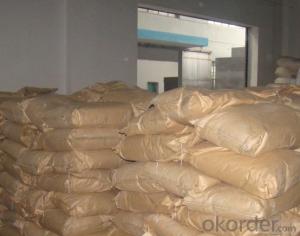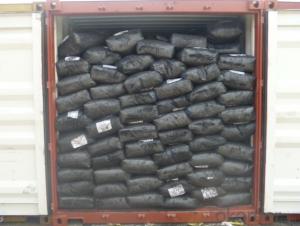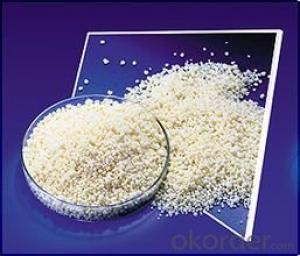RUBBER VULCANIZING ACCELERATOR NS Rubber Chemicals
- Loading Port:
- Tianjin
- Payment Terms:
- TT OR LC
- Min Order Qty:
- 25 m.t.
- Supply Capability:
- 12000 m.t./month
OKorder Service Pledge
OKorder Financial Service
You Might Also Like
RUBBER VULCANIZING ACCELERATOR TBBS(NS)
Chemical Name: N-Tertiarybutyl-2-benzothiazole sulfennamide
Molecular Formula:C11H14N2S2
Molecular Weight:238.37
CAS NO. : 95-31-8
Executive standard:GB/T21840-2008
Specification:
Item | Index |
Appearance | White or light yellow powder, granular |
Initial M.P,oC ≥ | 104.0 |
Loss on drying, % ≤ | 0.40 |
Ash, % ≤ | 0.30 |
Residues on 150μm sieve, % ≤ | 0.10 |
Insoluble in Methanol,% ≤ | 1.00 |
Free amine,% ≤ | 0.5 |
Properties: White or light yellow powder, granular. The density is 1.26-1.32. Soluble in benzene, methylene chloride, carbon tetrachloride, ethyl acetate, acetone, ethanol, dissolved gasoline, do not dissolve in water, acid, dilute alkali solution.
Application: Provides fast cure rate and high modulus development in NR, SBR, BR and blends. Normally used alone or with small quantities of ultra accelerators in tire compounds or industrial rubber products low poison and high efficiency. It is good back up for NOBS. Be regarded as standard accelerator.
Packaging: 25kg plastic woven bag, paper with plastic film bag, Kraft paper bag or jumbo bag
Storage: The product should be stored in the dry and cooling place with good ventilation, avoiding exposure of the packaged product to direct sunlight. The validity is 1 year
Note: The product could be ultra fine powder based on customer accurate requirement.
- Q: Chemical catalyst system baa?
- Catalyst is divided into inorganic catalyst and organic catalyst organic reaction generally need more catalyst, such as concentrated sulfuric acid
- Q: What is a catalyst and how does it make a reaction go faster?
- a catalyst is a substance that increases the rate of a chemical reaction, but is chemically unchanged at the end of the raction. the process is known as catalysis. calalysts work by lowering the activation energy of the reaction.
- Q: what is the role of a catalyst in a chemical reaction?
- A catalyst speeds up a chemical reaction by providing an alternate reaction pathway with a lower activation energy. Since the activation energy is lower, more product will be formed in the same amount of time.
- Q: Is it faster or slower? The What if you do not?
- Reduce or increase the energy required for the reaction, can also slow down, do not have no effect on the reaction
- Q: What is a Catalyst?
- Catalyst is a chemical substance which is used in chemical reactions in relatively small amounts to start up or increase the rate of the reaction without being consumed in the process. For example, Sulfuric Acid is used to dehydrate Ethanol to Ethylene. Enzymes in living beings are biological catalysts. Manganese dioxide, used to decompose Hydrogen Peroxide to Oxygen and Water. For detailed answer.... en.wikipedia.org/wiki/Catalysis
- Q: The beginning of the chemistry plus the catalyst and the plot without the Cuihua agent
- What image, rate or balance?
- Q: What is the difference between a catalyst and an inducer in a chemical reaction?
- The catalyst does not participate in the reaction, but only the carrier of the reaction; the inducer will participate in the reaction
- Q: Thorough explanation pls.
- A catalyst is a substance that increases the rate of a chemical reaction.
- Q: Explain how catalysts help to reduce costs in industrial processes !?Thanks
- Catalysts are efficient at converting starting materials to the final products. Since catalysts convert these materials to the product faster, less energy will be used, and often less other materials will be used to complete the process. Both will save the company save time and money. Not to mention the catalyst can be reused, often hundreds of times before it needs to be replaced. Hope that helps!
- Q: What are the catalysts?
- The catalyst is a substance that can change the rate of the reaction without changing the standard of the reaction Gibbs free, according to the definition of the International Pure and Applied Chemistry (IUPAC) in 1981, Enthalpy change. This action is called catalysis. The reaction involving the catalyst is a catalytic reaction. The catalyst will induce a chemical reaction to change, causing the chemical reaction to become faster or slower or to undergo a chemical reaction at a lower temperature The catalyst is also known as a catalyst in industry, and the composition, chemical properties and quality of the catalyst itself do not change before and after the reaction;
Send your message to us
RUBBER VULCANIZING ACCELERATOR NS Rubber Chemicals
- Loading Port:
- Tianjin
- Payment Terms:
- TT OR LC
- Min Order Qty:
- 25 m.t.
- Supply Capability:
- 12000 m.t./month
OKorder Service Pledge
OKorder Financial Service
Similar products
Hot products
Hot Searches
Related keywords

































